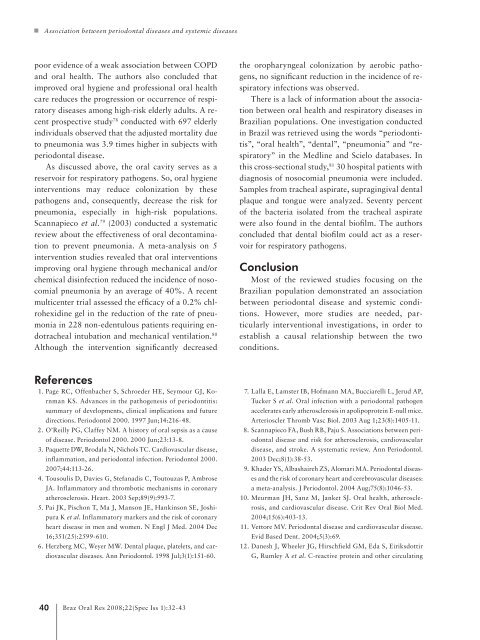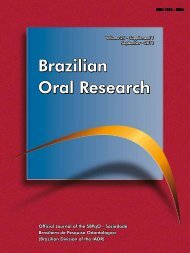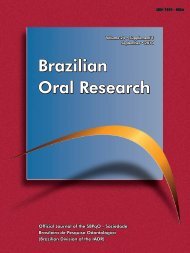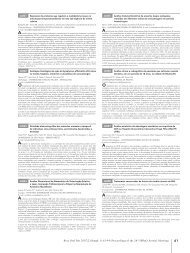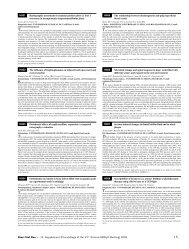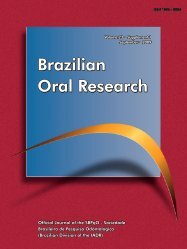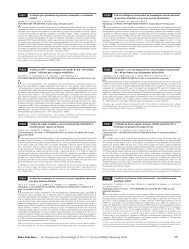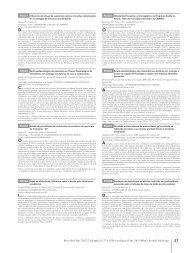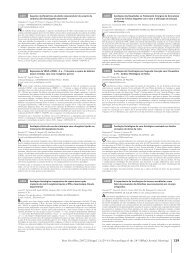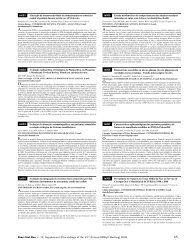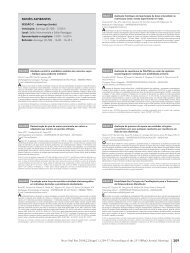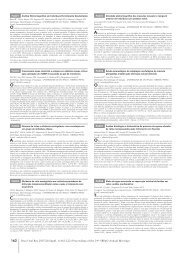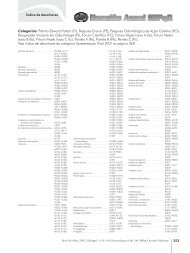Brazilian Oral Research Brazilian Oral Research Brazilian Oral
Brazilian Oral Research Brazilian Oral Research Brazilian Oral
Brazilian Oral Research Brazilian Oral Research Brazilian Oral
You also want an ePaper? Increase the reach of your titles
YUMPU automatically turns print PDFs into web optimized ePapers that Google loves.
Association between periodontal diseases and systemic diseases<br />
poor evidence of a weak association between COPD<br />
and oral health. The authors also concluded that<br />
improved oral hygiene and professional oral health<br />
care reduces the progression or occurrence of respiratory<br />
diseases among high-risk elderly adults. A recent<br />
prospective study 78 conducted with 697 elderly<br />
individuals observed that the adjusted mortality due<br />
to pneumonia was 3.9 times higher in subjects with<br />
periodontal disease.<br />
As discussed above, the oral cavity serves as a<br />
reservoir for respiratory pathogens. So, oral hygiene<br />
interventions may reduce colonization by these<br />
pathogens and, consequently, decrease the risk for<br />
pneumonia, especially in high-risk populations.<br />
Scannapieco et al. 79 (2003) conducted a systematic<br />
review about the effectiveness of oral decontamination<br />
to prevent pneumonia. A meta-analysis on 5<br />
intervention studies revealed that oral interventions<br />
improving oral hygiene through mechanical and/or<br />
chemical disinfection reduced the incidence of nosocomial<br />
pneumonia by an average of 40%. A recent<br />
multicenter trial assessed the efficacy of a 0.2% chlrohexidine<br />
gel in the reduction of the rate of pneumonia<br />
in 228 non-edentulous patients requiring endotracheal<br />
intubation and mechanical ventilation. 80<br />
Although the intervention significantly decreased<br />
References<br />
1. Page RC, Offenbacher S, Schroeder HE, Seymour GJ, Ko-<br />
rnman KS. Advances in the pathogenesis of periodontitis:<br />
summary of developments, clinical implications and future<br />
directions. Periodontol 2000. 1997 Jun;14:216-48.<br />
2. O’Reilly PG, Claffey NM. A history of oral sepsis as a cause<br />
of disease. Periodontol 2000. 2000 Jun;23:13-8.<br />
3. Paquette DW, Brodala N, Nichols TC. Cardiovascular disease,<br />
inflammation, and periodontal infection. Periodontol 2000.<br />
2007;44:113-26.<br />
4. Tousoulis D, Davies G, Stefanadis C, Toutouzas P, Ambrose<br />
JA. Inflammatory and thrombotic mechanisms in coronary<br />
atherosclerosis. Heart. 2003 Sep;89(9):993-7.<br />
5. Pai JK, Pischon T, Ma J, Manson JE, Hankinson SE, Joshi-<br />
pura K et al. Inflammatory markers and the risk of coronary<br />
heart disease in men and women. N Engl J Med. 2004 Dec<br />
16;351(25):2599-610.<br />
6. Herzberg MC, Weyer MW. Dental plaque, platelets, and car-<br />
diovascular diseases. Ann Periodontol. 1998 Jul;3(1):151-60.<br />
40 Braz <strong>Oral</strong> Res 2008;22(Spec Iss 1):32-43<br />
the oropharyngeal colonization by aerobic pathogens,<br />
no significant reduction in the incidence of respiratory<br />
infections was observed.<br />
There is a lack of information about the association<br />
between oral health and respiratory diseases in<br />
<strong>Brazilian</strong> populations. One investigation conducted<br />
in Brazil was retrieved using the words “periodontitis”,<br />
“oral health”, “dental”, “pneumonia” and “respiratory”<br />
in the Medline and Scielo databases. In<br />
this cross-sectional study, 81 30 hospital patients with<br />
diagnosis of nosocomial pneumonia were included.<br />
Samples from tracheal aspirate, supragingival dental<br />
plaque and tongue were analyzed. Seventy percent<br />
of the bacteria isolated from the tracheal aspirate<br />
were also found in the dental biofilm. The authors<br />
concluded that dental biofilm could act as a reservoir<br />
for respiratory pathogens.<br />
Conclusion<br />
Most of the reviewed studies focusing on the<br />
<strong>Brazilian</strong> population demonstrated an association<br />
between periodontal disease and systemic conditions.<br />
However, more studies are needed, particularly<br />
interventional investigations, in order to<br />
establish a causal relationship between the two<br />
conditions.<br />
7. Lalla E, Lamster IB, Hofmann MA, Bucciarelli L, Jerud AP,<br />
Tucker S et al. <strong>Oral</strong> infection with a periodontal pathogen<br />
accelerates early atherosclerosis in apolipoprotein E-null mice.<br />
Arterioscler Thromb Vasc Biol. 2003 Aug 1;23(8):1405-11.<br />
8. Scannapieco FA, Bush RB, Paju S. Associations between peri-<br />
odontal disease and risk for atherosclerosis, cardiovascular<br />
disease, and stroke. A systematic review. Ann Periodontol.<br />
2003 Dec;8(1):38-53.<br />
9. Khader YS, Albashaireh ZS, Alomari MA. Periodontal diseas-<br />
es and the risk of coronary heart and cerebrovascular diseases:<br />
a meta-analysis. J Periodontol. 2004 Aug;75(8):1046-53.<br />
10. Meurman JH, Sanz M, Janket SJ. <strong>Oral</strong> health, atheroscle-<br />
rosis, and cardiovascular disease. Crit Rev <strong>Oral</strong> Biol Med.<br />
2004;15(6):403-13.<br />
11. Vettore MV. Periodontal disease and cardiovascular disease.<br />
Evid Based Dent. 2004;5(3):69.<br />
12. Danesh J, Wheeler JG, Hirschfield GM, Eda S, Eiriksdottir<br />
G, Rumley A et al. C-reactive protein and other circulating


